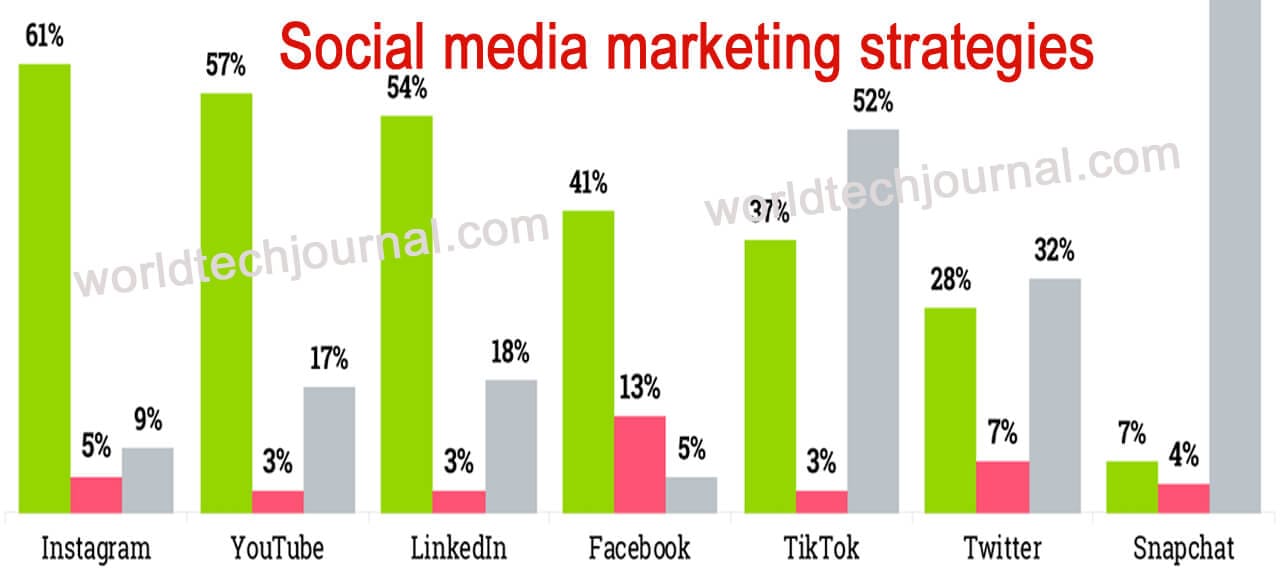To engage with your target audience, establish your brand, boost sales, create cash, and enhance website traffic, social media marketing involves using social media platforms.
Writing blogs, posting quality posts, engaging your social media users, assessing outcomes, and managing campaigns are just a few of the many jobs that go under the category of social media marketing tips and tricks.
Currently, Facebook, Instagram, Twitter, LinkedIn, Pinterest, YouTube, and Snapchat are the most popular and effective social media platforms for marketing.
You need social media marketing advice since, in today’s world, connecting with audiences on social media platforms has become the “most popular option” for content producers and enterprises.
It would not be an overstatement to say that social media is one of the most successful marketing platforms given the enormous rise in its user base over the last few years.
Marketers are aware of its enormous potential and have made great use of the finest social media advice.
Here in this guide I will discuss about 20 best social media marketing strategies to grow your business.
20 social media marketing strategy to grow your business
Too many companies engage in sporadically social media marketing. They are aware that they need to develop some social media marketing strategies, but they are unsure of what to do.

Because they are young and ought to be well-versed in social media, some businesses simply provide younger staff employees access to the company’s social media accounts.
Post and hope is no longer a viable social media strategy, however. Every company has to develop a social media marketing strategy and manage its social media accounts with care and restraint.
Social media strategies cannot be ignored by businesses. 36% of consumers who have had excellent customer service with a business are inclined to suggest it to others, according to Statista.
However, 96% of individuals who talk about businesses online don’t follow their social media accounts.
You still need to manage certain social media accounts even if you accept influencer marketing’s benefits. Influencer marketing often aims to drive traffic to your social media channels.
Influencer marketing should be seen as just a way for your company’s social media marketing strategy to grow.
Best 20 social media marketing strategies for your business is given bellow;
1. Choose social media marketing objectives that are relevant to practical
Many companies using social media have never taken the time to develop relevant and practical social media marketing objectives, which is one of the biggest issues they encounter.
They are on social media because they must be, but they are unsure of their purpose. So, this is one of the best social media marketing strategies for you I think.
Your social media marketing strategy must, of course, integrate with your overall company planning. In an ideal world, you would have established strategic objectives for the development of your company.
Your broad company objectives should complement your social media marketing objectives.
Achieve smart goals
All too often, individuals adopt vague company objectives that, upon closer examination, have little significance. If you examine your objectives, you’re not just setting them up for no reason at all.
Keep in mind that you are not setting objectives for their own sake. To assist you in creating the best social media strategy for your company, you are creating them.
As a result, you should make sure that your objectives are SMART:
- Specific
- Measurable
- Attainable
- Relevant
- Time-bound
Your chances of reaching your goals and, more significantly, knowing that you have increase with how SMART they are.
It’s important to create reasonable, practical objectives even when you want to push yourself.
Although most companies, even those that operate very well, are unlikely to reach one million Facebook followers in the next year.
Here, it might be wise to impose certain restrictions. Avoid trying to be successful on every social media platform.
There are too many, and your use of resources is inefficient. Just be effective on the social media platforms where your target market hangs out.
Social media objectives that your company might achieve
Your objectives will be particular to your company and will support your general objectives.
The following are examples of common social media goals kinds that you could take into account (couched in an appropriate SMART style):
- Increasing brand recognition
- achieving a target greater sales volume
- Increase your ROI
- attracting customers to boost in-store sales
- enlarge your audience.
2. Choose your most important metrics
Too many companies set up social media accounts, invest time and money into utilizing them and then wonder whether they are successful.
Because they are not the same for every organization, social analytics may unfortunately be a murky area.
Once again, the social indicators that are most important to you will be those that are related to the objectives that you have established for yourself.
How to Measure Influencer Marketing ROI is a free e-book produced by The Influencer Marketing Hub to assist you with this.
Avoid being seduced by vanity metrics that are simple to calculate, such as a person’s number of followers. We’ve already discussed why it’s a terrible idea to purchase Instagram followers.
Follower counts aren’t very useful as a measure since there are fraudulent followers on every social network.
Ideally, you should examine the marketing objectives you specified above and decide which metrics will tell you whether you are successful in achieving those objectives.
Post-reach is a significant statistic, for instance, if your objective is to raise your brand’s exposure. You can find out how widely your material is being shared on social media by using this tool.
The quantity of Clicks is something you should pay attention to if your objectives are more sales-based or if you want to persuade individuals to perform a certain action.
You may get a decent idea of what motivates individuals to purchase what you’re asking them to by tracking the number of clicks each campaign receives.
The responses to your postings will often pique your attention. This demonstrates how readers respond to your writing and if it resonates with them.
3. Select your social media audience by making a decision
Thinking that all of their followers would be beneficial to them is one of the biggest errors businesses make on social media.

There is a reason why analysts downplay the importance of the statistic Follower Numbers and refer to them as vanity metrics.
If a follower is not likely to be interested in the stuff you publish, having them is of little use.
The greatest issue with purchasing phony followers is certainly this. Fake followers don’t interact with your account, and for this you should not buy Instagram Followers.
Some are essentially robots and not at all actual humans. They most surely won’t attract new clients.
Whether they are actual or fraudulent accounts, these folks won’t buy any of your goods. They won’t recommend others to you. They are completely useless to you.
Review the objectives you specified in Step 1 now. Having followers on social media who are unable to support you in achieving your objectives serves little use.
Most of the time, you want your social media followers to be like your target audience.
There is no use in attempting to draw in a youthful social media audience of individuals whom either rent or still live with their parents if you are selling stairlifts to homeowners who struggle to stay mobile in their homes.
Targeting football players and their supporters makes little sense if you offer cosmetics and other beauty products.
If you offer items to a geographically unique market, this is very important. In such instances, you won’t want to have a large following from areas and nations where your items are unavailable.
4. Recognize your social media following
There are differences in the social media audiences. Social media is used in various ways by various sorts of individuals.
You must use the same social media platforms as your intended market if you want to achieve your objectives.
Similarly, to this, if you want to use influencer marketing, you must make sure that the influencers you work with have audiences that are similar to your target demographic.
You may be an executive in your mid-forties who utilizes Facebook.
However, you shouldn’t immediately assume that your clients will also be using Facebook if you don’t fit the profile of your company’s target market.
There were 1.96 billion daily active Facebook users in Q2 2022, but if you’re trying to attract a younger audience, your chances of success on Snapchat or Instagram are far higher.
However, if your company focuses on the 25 to 34 age group, which makes up 30.1% of Facebook users and is their most popular age group, you should know that.
Examine the objectives you previously specified for social media marketing. Which social media platforms will assist you in achieving your objectives the most?
You need to have a thorough grasp of your clientele so that this. The moment has come to resurrect whatever personalities you may have created for your ideal clients.
What are the characteristics of your consumers, and how do they use the internet?
You will be more successful in reaching your target market on social media if you have a deeper understanding of their psychographics and demographics.
5. To reach your audience choose right social media platforms
Some individuals wonder how they would have the time and energy to manage accounts on all of the social media platforms.
You often don’t have to. Just choose the appropriate social media platforms for your company. You want to learn which social networks are most popular with your target market.
To find out how much time your target audience spends there, you may need to do some preliminary research.
This shouldn’t be too difficult, especially if you are familiar with your clientele. Ask them for their favorite social media accounts in a survey if you don’t already know this.
If a sizable enough portion of your audience has active social accounts, you may start with their chosen network and then expand.
Generally speaking, you wouldn’t need to visit more than three to five social networks.
Here, we’re using a definition of social networks that is rather wide. Of course, you take popular platforms like Twitter, Facebook, and Instagram into account.
If your target audience utilizes video platforms in big numbers, you may also consider looking at YouTube and TikTok.
Live streaming services like Twitch may sometimes be appropriate for your audience as well.
Your audience doesn’t utilize social networks, therefore don’t spend time on them.
You should be present on social networks if a significant fraction of your target audience uses them. You may pass on a platform and not waste your time and money if they don’t show much interest in it.
To make your life simpler, you need also to take another aspect into account. To batch-schedule posts in one location, many companies find it more convenient to employ a social media marketing platform.
1 media marketing platform that enables them to batch-schedule articles in one location.
As a result, you may choose to match the social media platforms that your desired social media marketing platform supports with the ones you utilize.
This may be less important for live-streaming platforms like Twitch, where you essentially run a live channel, and video-sharing platforms like YouTube, which don’t employ content feeds and focus more on content channels.
You may also want to think about whether you want many profiles on social networks, each aimed at a certain audience, or a single account for the whole organization.
You may, for instance, have many Twitter accounts, each with a distinct purpose.
If you have an abundance of resources, you might potentially create many YouTube channels, each with a specific target market.
See also how to become a YouTuber and get more views in 5 easiest ways.
6. Investigate the social media strategies of your rivals
Most businesses don’t run alone. A social media strategy will often be used by your rivals. You’ll need to understand what they’re doing for sure.
What do they prioritize? Whom are they aiming for? Which words are they attempting to dominate?
You can rapidly analyze your competition to learn more about its advantages and disadvantages. This ought to help you have a better idea of what consumers could anticipate from companies in your sector.
You may be able to identify the social weaknesses of your rivals and take advantage of the openings.
For instance, even though your target audience is active on Facebook, one of your rivals may be well-known on Twitter but have little to no presence there.
If so, investing more time and money into Facebook could be more advantageous than directly competing on Twitter.
You might snoop on your rivals and find out which of their social media posts was the most popular by using a program like Buzzsumo.
You may create and distribute comparable, but superior, content if you understand the sorts of content that appeal to people on certain social media platforms.
7. Create a social media budget that is reasonable
Let’s be practical. No company should just give social media accounts lip attention.
For the majority of businesses, social media marketing is just as effective a kind of advertising as any other, so you should be ready to set aside money for it.
If you just add social media tasks to the list of responsibilities your current office personnel already has, you can’t expect success.
However, if you aim to raise brand recognition and awareness or, at the very least, sales, you shouldn’t spend more on your social media efforts than you can reasonably expect to make.
As with any kind of marketing, you should consider the objectives you defined earlier in your strategy when calculating the return on investment (ROI) from your social media budget.
Consider how much you plan to spend on all of your digital marketing across all channels when you create a social media budget. How much of your budget are you willing to set aside for social media?
Most businesses spend between 5% and 15% of their yearly sales on marketing, according to some simple estimates performed by WebStrategies for a typical business.
The majority of people spend between 35% and 45% of that on digital marketing initiatives.
As a result, social media marketing accounts for 15% to 25% of most businesses’ digital marketing budgets (organic and paid).
8. Make a list of the content categories you want to share
Naturally, you’ll need excellent material to post if you want to succeed on social media. Sharing excessive promotional content is one of the major errors that companies make.
Keep in mind that social networks were never meant to serve as a marketplace where you could sell your goods; rather, they were created to be social.
As a result, you should balance the information you offer on social media to include a blend of interesting and educational pieces as well as a modest amount of commercial materials.
Additionally, you must like and distribute other people’s stuff.
This is likely the main factor contributing to the status of the majority of influencers. They provide the ideal material for their followers since they have a solid understanding of their audience.
The same is required of you as a brand.
You should have a good notion of the kind of material that will appeal to your target audience if you have already identified your objectives and studied what works (and what doesn’t) for your competitors.
Making material for those who won’t ever assist you achieve your objectives serves little use.
Regarding what you can produce, be honest.
You must be aware of any restrictions you could experience while producing material.
For instance, you could desire to operate a fantastic YouTube channel, but it is useless to do so if you lack the necessary tools, resources, expertise, and time to produce high-quality videos.
A YouTube channel with only one or two shoddy talking head videos is not something you want.
Similar to live video streams, arranging them is useless if no one is available to appear in front of the camera during a live broadcast.
You should strike a balance between the kinds of content that appeal to your target audience the most and the kinds that you feel most qualified to create.
Keep your preferences apart from those of your target audience.
You or the person in charge of your company’s social media accounts is likely to also manage personal accounts. Making a distinction between the two account kinds is necessary.
Simply because you like making a certain style of post on your accounts does not guarantee that it will be successful on the accounts of the business.
Presumably, you only write about topics that interest you. However, you must only consider the preferences of your target market while managing the business account.
You want to write articles for them that will fascinate, amuse, and inform them.
Your specialty themes should presumably be written down. This is especially crucial when curating material.
For instance, you should only retweet tweets that are relevant to your area of expertise.
Read also 10 content marketing tips and tricks to reach audience fast.
9. Set up your account correctly before starting to produce and promote content
You must properly configure your accounts. All of your social media platforms should have a unified aesthetic style. On each network, use the proper hues, logos, and related visuals.
Spare no social space. Spend some time properly completing your biographies and profiles.
Make sure to connect to pertinent websites, and you may even designate unique landing pages on your website for visitors who arrive via your social media accounts.
It is worthwhile to take the time to make sure that all of the photographs on your biographies and profiles have been posted in the highest quality possible for the social network.
When creating each account, keep your target audience in mind. Based on your bio or profile, consider if this audience will be interested in your page.
10. Establish a content schedule and decide when to publish
Even while you could create each social media post by hand, doing so would be inefficient and may not provide the greatest results.
To filter the results, they provide to users, the majority of social networks today use some kind of algorithm.
Therefore, if you publish material at a time other than when your target audience is online, they could never see it.
To set up and manage several posts at once, you should ideally utilize one of the social media scheduling tools. Many social media marketing platforms have been examined by us.
You can be sure that at least one of these will simplify your life. See our article on the best social media scheduling tools.
Different people have different ideas about how many posts you should publish on each network each day and when those posts should be published.
We’ve previously created articles outlining the ideal times to post on Facebook, Instagram, and TikTok.
11. Make appropriate material to share with your audience
When producing content, you should consider the following four questions:
Remember the value of pictures and videos.
More than 40 times more probable than other forms of material, visual content gets shared on social media. Over the last several years, Instagram has gained enormous traction and developed a strong visual emphasis.
Top Instagram companies have an engagement rate of 4.21% for each follower. That compares to 58 times more on Facebook and 120 times more on Twitter.
It seems like video material is becoming more and more popular every year. YouTube claims that the amount of mobile video viewing increases 100% yearly.
Customers claim that after seeing a video on a product, 64% of them are more inclined to purchase it online.
Make varied stuff.
You don’t want all of your social media material to seem the same, even while you want your content to have a general appearance, especially within certain social campaigns.
Variety in social feeds is what people react most to. Depending on the social network, they choose a combination of alluring images, engaging videos, and even persuasive writing.
You may still change the composition of posts inside a medium, even if some social networks only permit one or two of these content kinds.
Consider the situation when your business is catering. In that case, sharing close-up, mouthwatering food shots on Instagram may be your preference, but don’t rule out sharing other kinds of photos and sometimes even videos.
When someone visits your Instagram profile, reads your bio, and views all of your posts together, they want diversity without it being chaotic.
On Instagram, Wendy’s does a great job doing this. Even though it’s obvious you’re seeing food from a fast-food chain, the post content differs.
They remain committed to their brand while highlighting inventiveness and color. A variety of memes, comedies, pictures, and appetizing food photos are included.
For Each Social Network, Create Unique Content
Keep in mind that not all social media platforms are created equal. For each network, you should ideally tailor your content.
There is a self-imposed character restriction on Twitter of 280 characters for each tweet. As a result, your message must be succinct and direct.
Links are allowed in tweets and hashtags (but no more than 1 or 2). Images in tweets perform far better than those without.
Although Facebook postings might be lengthier than tweets, don’t go overboard. A text-heavy page may quickly turn readers off.
Even if you are only sharing material that has been carefully selected, it is always a good idea to add some own commentary.
On Facebook, short videos work well. For every Facebook post, include a picture or a video, but link them to the text. Facebook link postings often get good engagement.
Because Instagram is an image-based social network, you should post engaging, relevant images and brief videos.
By combining these with the help of a reliable video compressor, you may create a narrative that will appear at the top of users’ feeds rather than blending in with other postings.
Pinterest is likewise heavily focused on images. On themed boards, individuals do in fact pin photos. Therefore, you should center your Pinterest content on a pinnable image.
If your target market is mostly female, Pinterest might be ideal for artistically showing items.
Since LinkedIn is a professional network, you must make sure that all of your postings are appropriate for its users.
People often read postings on LinkedIn to learn more, especially about topics that might advance their careers.
See also the essential guide to LinkedIn outreach for generating B2B lead.
YouTube
Of course, medium- to long-form videos may be found on YouTube. You create a channel and upload videos to it, ideally adhering to a general theme.

To stand out from the other YouTube channels, you need something. To let your viewers know they can regularly anticipate new videos, try to release at least one video every week.
Generally, you should refrain from just uploading your current television advertisements. Make and upload only professional-caliber videos.
Making engaging films that include your items is one approach to avoid producing videos that appear overtly commercial.
See also 5 stages to improve YouTube content strategy.
12. Boost your social media accounts
You still need to build your first following even if outstanding content will eventually sell your social channels. Before someone may decide to follow you, they need to locate your channels.

You may advertise your channels in a variety of ways, some quite obvious and others more covert.
On your website’s main page, in the footer, and on your About and Communications pages, for example, you should add links for all of your social media profiles.
In any emails and newsletters, you send, if you have an email list, you should make mention of your social media accounts.
At the bottom of every email, you can quickly include links for your social media accounts.
Of course, you may advertise your social media accounts offline as well. Include them in your old-fashioned marketing and retail signs.
Many companies cross-promote on many social media platforms. You might, for instance, use Twitter to advertise your YouTube channel.
You may have noticed that the profile pages of the majority of YouTube channels mention the channel owner’s other social media profiles.
To improve brand awareness and your social following, you may even run advertising on your social media platforms to a highly focused demographic.
13. Be Active with Your Audiences
People don’t only read, look at, or watch material on social networks. They use the internet to socialize and communicate with others.

Successful businesses don’t merely advertise to their social media followers. They converse with them as well.
Because of this, unless you have a highly wide target market and an army of staff members devoted to this effort, you shouldn’t try to cover every social network.
You may make the most use of your resources by concentrating on the social media platforms that your target market uses.
Custom hashtags have proven to be highly helpful for certain businesses.
These not only promote conversation and sharing but also make it simpler for you to look for postings that mention your company.
To show that you value your customers, you should reply to any mention of your company on social media.
14. Build an Online Community for Your Followers
Making a distinct community for your audience is one of the finest methods to engage them. Every day, you want to be one of their “go-to” locations.
Creating a persona online is an essential component of this. You want to make sure that people don’t see your company as a soulless organization and that it has heart and soul.
Try to include your readers in your postings by making them interactive. Make it a point to solicit their feedback. You may add polls and questions to get feedback from your followers.
Make sure your postings are intriguing and noteworthy at all costs. Don’t just repeat your adverts verbatim. Your followers must find your content useful if you want them to read them again often.
Whom you choose to manage your social media platforms is one thing you should think about. They should ideally be workers who fit your target audience’s social demographics.
Use your youngest staff members to manage the business’s Instagram and TikTok profiles if you’re trying to appeal to Generation Z.
If you want to reach house renovators, you could consider asking current homeowners to manage your company’s Facebook page.
You might join and establish appropriate groups based on the social media platform of choice for your target demographic.
Facebook groups are great for B2C companies; if your emphasis is more on B2B, think about using LinkedIn. To motivate your audience, you may start a group on one of these platforms.
Your organization can be the best location for the network.
15. Think about using paid promotion to grow your audience
You may purchase some kind of sponsored advertising on most social networks. Most will let you demographically target your adverts so that only members of your chosen target audience see them.
Paid advertising enables you to connect with relevant audiences that you are presently disconnected from.
Advertisements may help you sell things, increase brand awareness, or promote certain articles or videos.
16. Think about working with influencers
We are aware of the benefits of using influencers and influencer marketing, of course.
You have the opportunity to reach a whole new audience, one that perhaps will be interested in your company and its goods, if you choose the proper influencers.
Influencers’ power lies in the fact that they have already mastered the art of social media marketing. They have a strong internet reputation and a sizable following of eager and engaged viewers.
You may think about collaborating with influencers to get their following on your social media pages. Naturally, you will need to provide material that will keep their attention once they get on your site.
You have a possibility that the individuals the influencers drive your way will also become your social followers if you choose influencers whose followers align with your target demographic and you provide them with high-quality material.
17. Think of cooperating with Brand Advocates
You may already have access to enthusiastic, informed individuals who are willing to spread the word about your company on social media.
These brand promoters might be a part of your social media marketing plan.
They may not be as well-known as the leading influencers in your industry, but some of them will already have sizable followings and reputable reputations, giving you the benefit that they are already familiar with and interested in your offering.
Simply put, brand advocacy is when customers who like your product or service continue to support your business by introducing it to new audiences.
Being passionate about what your firm does, and your brand advocates may significantly contribute to word-of-mouth marketing and generate new business.
The members of your senior leadership team, business partners, staff, and current customers may all serve as brand ambassadors.
18. Incorporate Chatbots into Your Social Media Marketing Strategy
You may think about including a chatbot if you communicate with your followers using messenger-type applications like Facebook Messenger or WhatsApp.
These may assist you with resolving issues for your present or future clients without the need for human intervention.
The biggest advantage, according to SocialBee, “might be that a chatbot will give your customers a smart assistant with the ability to communicate with them almost like a human consultant, and it will gradually start to get to know your customers and which of your products they are interested in.”
If employing a chatbot intimidates you, you don’t need to know how to code or have to hire a pricey development team.
For a monthly charge, you may incorporate several current chatbots into your social media networks.
19. Run campaigns that extend channels
Nowadays, a lot of companies have many social media accounts and connect them via cross-channel advertising. Even your brand champions and influencers may participate in these efforts.
Naturally, you could have a lot of company social media accounts if you offer a variety of items to target various demographics.
This does not imply that you must include each social media account in each campaign. Concentrate on the accounts that correspond to the target market for a particular campaign.
Every social media platform has its peculiarities and methods of operation. Like how Twitter was the birthplace of hashtags. Although you shouldn’t utilize more than one or two of each tweet, they are still crucial.
There is a set character restriction of 280 on that network as well. You may use up to 30 hashtags in an Instagram post, which makes it look like hashtags are becoming even more popular.
However, they don’t like it when you use the same set of hashtags in a lot of your postings.
But even if Facebook users sometimes use hashtags, they haven’t taken off there the way they have on Instagram, Twitter, or even TikTok.
Therefore, in a cross-channel campaign, you cannot just deploy the same pieces of material, unchanged, across all of your social networks.
A cross-channel campaign should be seen as one big tale that you convey consistently across all of your social media channels.
Your audience, especially those who follow you, your influencers, and your brand advocates across several social networks, should not feel as if you are repeating yourself.
You should thus convey a linked, coherent tale. Sharing just the kinds of material that each network excels at for your campaign is one method to do this.
For instance, you would only post campaign-related photographs to Instagram, longer videos to YouTube, shorter videos to TikTok, and crisp, succinct 280-character tweets to Twitter (while making sure to include an appropriate hashtag).
For any cross-channel strategy, you’ll want to maintain consistent branding across all of your social media posts.
A comprehensive landing page with additional information about your campaign and links to all of your messages would be ideal.
20. Monitor your progress and modify your social media strategy as necessary
There is, of course, no assurance that your social initiatives will be successful no matter how well you organize them.
However, you won’t know the effectiveness of your social media initiatives if you don’t monitor your outcomes.
Setting objectives was the first step in the process, followed by choosing your most important metrics. As a result, you should constantly monitor the development of these KPIs.
Are these analytics responding to your social media operations as expected?
For more social platforms, several of them also provide stats. Numerous social networks give their analytics tools, which will supply the majority of the required data.
You can discover statistics sections on Twitter and YouTube as well as an insights area for your Facebook page.
Utilize these tools to monitor your progress. Create more of that kind of material if they demonstrate that you are creating well-liked, widely shared content.
If your content isn’t doing well, pay attention to what is and change your social media sharing to concentrate on the topics your followers are interested in.
To learn what your social audience thinks of your social media marketing strategy, you may also think about polling them. You never know when your followers may provide you with useful suggestions.
If there’s a possibility that changing anything may help you advance your social success, don’t be hesitant to do it.
Final words
Social media marketing is an important way to connect with customers and promote your company or product.
It allows you to reach a large audience quickly and easily, and can be used to build relationships with potential customers.
Social media can be used to:
– Connect with customers and build relationships
– Promote your company or product
– Get feedback and feedback on your product or service
– Monitor customer sentiment and feedback
– Track customer engagement and trends
– Generate leads and sales
– Create a brand presence
– Generate content for your website and social media
However, in this guide I have discussed about social media marketing strategies to grow your business. You can share your thoughts and ideas in bellow.
Recommended articles:
How to increase organic social media reach?
5 main types of social media networks with benefits
Top 20 benefits of social media for business
Best 10 tips to write engaging social media post
Types of social media marketing with 10 pros and cons
Top 10 content marketing tips and tricks to reach audience fast
10 best marketing techniques to drive business expansion
Detail guide to affiliate marketing | 150 plus affiliate programs





Everything is very open and very clear explanation of issues. was truly information. Your website is very useful. Thanks for sharing.
I think this is one of the most important information for me. And i’m glad reading your article. But should remark on few general things, The website style is perfect, the articles is really excellent : D. Good job, cheers
very nice post, i certainly love this web site, carry on it